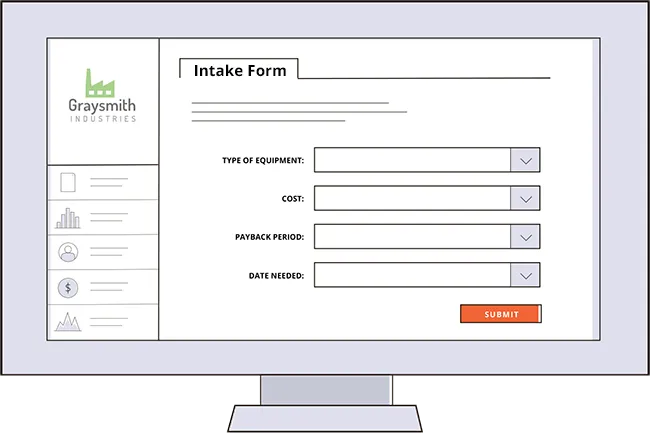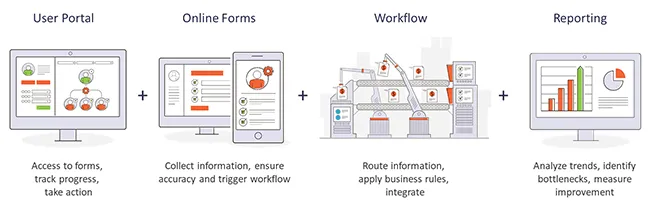What is an intake form?
Table of contents

An intake form is a structured form used to collect key information at the start of a business process, such as onboarding a client, employee, or vendor. These forms standardize data collection and can be automated for faster, more accurate routing. By using custom online intake forms, organizations reduce manual errors, improve turnaround time, and enhance the overall experience for both internal and external users. With Nutrient’s intake form software, you can build dynamic forms, automate approvals, and integrate data with your CRM or ERP system for a seamless intake process.
An intake form collects structured information to initiate a business process — whether for a new client, project, hire, or vendor. It serves as the first step in onboarding by gathering all necessary data to assess, route, and fulfill a request through an automated workflow.
Examples include
- Client intake — Manage the client intake process to ensure new customer information is captured and the onboarding process runs smoothly.
- Project intake — Capture critical details for new projects, assess if the project is a good fit, and distribute assignments to the correct resources.
- Employee/new hire intake — Provide new employees with an efficient onboarding experience so they can start contributing from day one.
- Vendor intake — Assess and onboard new vendors, collect important vendor information, and integrate with finance for billing.
- Patient intake — Give new patients a better, less stressful experience when completing paperwork and notifying medical staff.
Try Workflow Automation free for 14 days
Benefits of using intake forms
Using intake forms can bring numerous benefits to businesses and organizations. By implementing intake forms, organizations can streamline their data collection process, improve the client experience, and ultimately provide better services to their clients. Intake forms are a powerful tool that can transform how businesses interact with their clients, ensuring all necessary information is captured accurately and efficiently.
Streamlined data collection
One of the primary benefits of using intake forms is the ability to standardize the information gathering process. By creating a consistent format for collecting client data, businesses can ensure they’re capturing all the necessary details in a structured manner. This can help reduce errors, improve data accuracy, and make it easier to track tasks and manage orders. With intake forms, businesses can gather essential information quickly and efficiently, leading to a more organized and effective workflow.
Use Nutrient’s drag-and-drop builder to streamline intake, automate workflows, and reduce manual errors.
Improved client experience
In addition to streamlining data collection, intake forms can also enhance the client experience. By gathering essential information upfront, businesses can tailor their approach to better serve each individual client. This can lead to increased client satisfaction, improved relationships, and ultimately, a stronger reputation for the business. An effective intake form can make the onboarding process smoother and more enjoyable for new clients, setting the stage for a positive and productive relationship.
Intake forms and processing for any business
No matter your industry, every successful process starts with clean, structured intake. From HR and legal to healthcare and finance, intake forms help teams kick off work efficiently and consistently — reducing back and forth and keeping data organized from the start.
Intake software provides employees, vendors, and customers with a convenient, user-friendly intake process.
Properly using intake forms and an automated intake process will save your employees time and effort and reduce any accidents caused by human error. Imagine if, while doing data entry by hand, one of your team members mistakenly makes a typo or copies the wrong basic information field when entering a client or potential client. It’s a simple error anyone can make, but it could cause significant problems(opens in a new tab) or require hours to hunt down the error and fix it afterward. A custom online intake form can avoid mistakes like this and save time and money.
Whether you’re onboarding clients, hiring employees, or handling patient intake, Nutrient helps you build the right form — fast.
- Users can complete user-friendly intake forms, track progress, and receive alerts/reminders via email or on their devices as statuses change.
- Once forms are submitted, they’re routed based on the business rules you set, based on any form fields.
- All activity related to every request is tracked for complete visibility.
- Bottlenecks in the process are identified and streamlined for faster turnaround time.
Our form intake software is entirely customizable to your needs, no matter your industry or use case.

Intake form description/summary
The diagram above shows how the system collects, tracks, and routes individual requests to the proper staff for processing:
- Internal and external users have access to an intake portal where they can submit service requests and track the status of their requests.
- They can also take any necessary follow-up actions and provide feedback to staff regarding request fulfillment.
- Portal administrators create request-specific forms that collect all required information to ensure the system delivers request information in the proper format.
- Administrators also create business rules that route submitted forms as needed.
- Processes can be simple, single-threaded flows from A to B to C, or complex, multithreaded flows that branch off based on logic built into the workflow.
Designing an effective intake form
Designing an effective intake form is crucial for gathering essential information from clients, streamlining the intake process, and providing a positive user experience. A well-designed intake form can help service providers understand client needs, tailor their services, and build stronger relationships with clients. To create an effective intake form, consider the following tips:
- Clarity and simplicity — Ensure the form is easy to understand and complete. Avoid using jargon or complex language that might confuse clients.
- Essential information — Focus on gathering only the necessary information. Too many fields can overwhelm clients and lead to incomplete forms.
- User-friendly design — Make the form visually appealing and easy to navigate. Use clear headings, logical sections, and intuitive input fields.
- Mobile compatibility — Ensure the form is responsive and works well on mobile devices. Many clients will complete the form on their phones or tablets.
- Feedback mechanism — Include a way for clients to provide feedback on the form itself. This can help you identify areas for improvement and ensure a better user experience.
By following these guidelines, you can create an effective intake form that meets your business needs and provides a positive experience for your clients.
Try our customizable intake form builder to create client-ready forms in minutes.
Additional intake features
A request intake form builder provides drag-and-drop tools for developing workflows that follow preset business rules and ensure requests are assigned to the best person to handle them. You can base assignments on a role, management level, department, or another attribute.
- Alerts can be configured to indicate that a new request has been submitted.
- Intake data can be pushed into existing CRM, ERP, database, or any other system of record.
- HIPAA-compliant online forms can be created to protect patient confidentiality and medical history.
- Reminders can be set at preset intervals to ensure assigned staff promptly handle requests.
- Escalations and task delegations ensure backups are in place in case of inaction or staff vacations.
- The requester can track the progress of the request and see who is currently working on it.
- Consent forms can be designed to include eSignatures.
Document and file intake form examples
If your intake process requires collecting documents and files, you can build custom, web-based document collection forms that meet your business needs. Clients, employees, and vendors can review requirements and then attach relevant files to your organization for review, approval, and filing. A document intake form simplifies collecting critical information and ensures documentation requirements are met, streamlining the intake process and reducing turnaround times.
But you’re not limited to documents. Users can attach permissible files to a form — images, videos, spreadsheets, PDFs, schematics, and more. This can be a huge win for law firms, engineering firms, banks, and other paper-intensive organizations.
Intake form example use case: Client intake form
Client intake forms are essential tools for many businesses, serving as the foundation for successful onboarding and long-term relationships. They capture key project and contact information needed throughout the client lifecycle.
In the legal sector, for example, intake forms are used to gather detailed information about a client’s legal matters, helping firms tailor their services more effectively from the start.
The intake process typically begins with a custom form, completed by either the client or the vendor. It may include:
- Primary point of contact details
- Additional client contact information
- Executive sponsor
- Project description or executive summary
- Project start and end dates
- Deliverable confirmation
- Billing or invoicing information
A well-designed client intake form ensures both internal teams and clients have a secure, consistent way to exchange critical information, in turn laying the groundwork for a smooth client onboarding process.
Building forms with Nutrient Workflow
Our Form Designer has been built from the ground up to make it easy for business users to develop great-looking forms quickly. Include complex form logic, line items, or any other form element you need.
- Add images, videos, tables, and links to any form
- Create once, reuse across multiple processes
- Create reusable “form parts” containing fields or other form objects
- Create responsive, mobile-friendly forms
- Create forms for employees, customers, clients, and vendors
- Employ powerful form logic to show and hide any form element
- Make us of our low-code, drag-and-drop design
- Select from a wide variety of field types
- Use CSS to further style form elements
- Use calculations and formulas within any field
- Use flexible, multicolumn layouts
- Use JavaScript natively for advanced form behavior
Start building intake forms today using our low-code form builder — no technical skills required.
With our form designer and workflow builder, you can quickly automate any business process — from form approval workflows, to incident management, and everything in between.
Try the form builder for free or talk to our team about your specific workflow.
FAQ
Use intake forms to collect structured information at the beginning of a business process such as onboarding, requests, or service fulfillment.
Client onboarding, employee hiring, vendor enrollment, project planning, and medical intake are common examples.
Yes. Users can upload files like PDFs, spreadsheets, videos, and scanned documents directly through the form.
Yes. Nutrient forms integrate with CRMs, ERPs, databases, and other systems via APIs and connectors.
Automation eliminates manual steps, routes forms based on logic, sends reminders, tracks status, and improves turnaround time.







